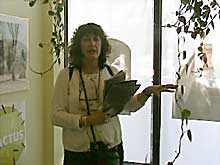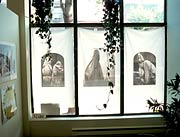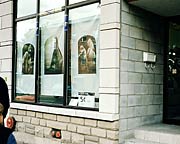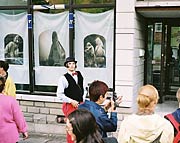


Originaire de la Saskatchewan, Eileen Leier a étudié les arts plastiques à Vancouver, à l'Unviersité Simon Fraser et au Emily Carr Institute of Art and Design, la photographie au San Francisco Art Institute de Californie et a terminé, en 1995, une maîtrise en arts visuels à l'Université Concordia à Montréal. Ses œuvres ont été présentées dans le cadre d'expositions individuelles et collectives dans l'Ouest du Canada, en Ontario, au Québec, de même qu'en Californie, en Écosse et en France. Ayant longtemps séjourné au Québec, elle vit et travaille maintenant en Colombie-Britannique.
Impressions digitales Cactus
4600, boul. Saint-Laurent
Ainsi positionnés dans des alcôves, les arbustes anthropomorphes de ce triptyque adoptent une attitude de recueillement ou de compassion qui évoque presque une scène de piété. L’humanité qui se dégage de chaque forme est d’ailleurs si manifeste qu’il nous est difficile de croire que des végétaux sont bel et bien cachés sous les toiles. Transposé dans la ville, le sujet se distancie complètement du contexte naturel duquel il est issu, soulevant une réflexion sur le pouvoir d’évocation d’une œuvre in situ.


Originally from Saskatchewan, Eileen Leier began her art studies with a Bachelor of Arts at Simon Fraser Uiversity and graduated with a Bachelor of Fine Arts from Emily Carr Institute of Art and Design in Vancouver, British Columbia. She has also studied photography at the San Francisco Art Institute in California and completed a Master of Fine Art in 1995 at Concordia University in Montreal. Eileen Leier has shown her work in both group and solo exhibitions throughout Western Canada, Ontario and Quebec, as well as in California, Scotland and France.
The Landscape Series / Québec City
Through its placement in alcoves, this triptych of anthropomorphic bushes takes on a contemplative or compassionate demeanour that almost evokes a devotional scene. Humanity exudes from each form and seems so manifest that one can hardly believe that it is only plants that are hidden under the drapes. In its transposition to the city and consequent removal from its natural context the subject interrogates the evocative force of an in situ work.
Excerpt from
Villeneuve revisited
by Sylvette Babin
Translation by
Bernard Schutze
STATEMENT
My work for Tour de Villeneuve contains 3 black and white photographic images of urban landscapes in winter. The focus within these landscapes are trees that have been wrapped and bound in cloth or burlap and fastened with rope or twine. The wrapping of trees with fabric is a tradition in Quebec that serves as a protection against the severe cold, snow and winds of winter.
The trees, encased completely in fabric and battered by winter storms, appear in postures reminiscent of the human body. Bent over and huddled together the trees seem to gesture and pose in small groups, in couples or as a solitary figure. The cloth bindings often completely disguise what is within. There is a visual disjunction which occurs between the knowledge of the interior tree and its external appearances. When bound with fabric into these forms, the trees undergo transformation. Photographing these trees and bringing them from an outside location in winter to an interior commercial site in summer, creates another type of disjunction. They no longer retain their original function within the landscape. The visual and functional disjunctions within this work raise questions about our abilities to both redesign and to re-designate the landscape.
The location for these images on the "Tour de Villeneuve" is in the windows of a store front on St-Laurent. Cactus is a business which provides digital services to clients including all forms of production and printing processes. The black and white photographs of wrapped trees have been digitally altered, the trees isolated and removed from their original background locations. The photographs were then digitally printed onto long panels of fabric. There were 3 "tree banners" suspended from the ceiling in the windows of Cactus, facing outwards towards the street. A light weight grade of fabric have allowed the banners to hover and move with the air currents within the store, with the physical movements of clients, viewers and personnel.
